AST-1306 TsOH (Synonyms: Allitinib) |
| Catalog No.GC15669 |
AST-1306 TsOH (AST-1306 (TsOH)) is an orally active and irreversible EGFR and ErbB2 inhibitor with IC50s of 0.5 and 3 nM, respectively. AST-1306 TsOH also inhibits ErbB4 with an IC50 of 0.8 nM. AST-1306 TsOH is an anilino-quinazoline compound and has anti-cancer activity
Products are for research use only. Not for human use. We do not sell to patients.

Cas No.: 1050500-29-2
Sample solution is provided at 25 µL, 10mM.
AST-1306 is a selective, irreversible inhibitor of ErbB2 and EGFR with IC50 values of 0.5nM and 3nM, respectively [1].
AST-1306 is designed and synthesized based on the chemical structure of lapatinib. The molecular docking method shows AST-1306 binds to the ATP-binding pocket of the kinases and form covalent bind with certain amino acids. AST-1306 can inhibit EGFR and ErbB2 in a cell-free assay with more than 3000-fold selectivity to other kinases. Besides the wild-type EGFR, AST-1306 also inhibits EGFR mutant T790M/L858R both in a cell-free assay and in HIH3T3 cells. The growth of the cells is suppressed by AST-1306 due to the inhibition of the phosphorylation of EGFR. It also occurs in some human cancer cells. Experiments have proved that AST-1306 notly inhibits the phosphorylation of EGFR and ErbB2 and subsequently decreases the downstream pathways of these kinases in A549 cells, Calu-3 cells and SK-OV-3 cells. Moreover, AST-1306 potently inhibits the tumor growth both in ErbB2-overexpressing xenograft models and FVB-2/Nneu transgenic mouse model [1].
References:
[1] Xie H, Lin L, Tong L, Jiang Y, Zheng M, Chen Z, Jiang X, Zhang X, Ren X, Qu W, Yang Y, Wan H, Chen Y, Zuo J, Jiang H, Geng M, Ding J. AST1306, a novel irreversible inhibitor of the epidermal growth factor receptor 1 and 2, exhibits antitumor activity both in vitro and in vivo. PLoS One. 2011;6(7):e21487.
| Cas No. | 1050500-29-2 | SDF | |
| Synonyms | Allitinib | ||
| Chemical Name | N-[4-[3-chloro-4-[(3-fluorophenyl)methoxy]anilino]quinazolin-6-yl]prop-2-enamide;4-methylbenzenesulfonic acid | ||
| Canonical SMILES | CC1=CC=C(C=C1)S(=O)(=O)O.C=CC(=O)NC1=CC2=C(C=C1)N=CN=C2NC3=CC(=C(C=C3)OCC4=CC(=CC=C4)F)Cl | ||
| Formula | C31H26ClFN4O5S | M.Wt | 621.08 |
| Solubility | DMF: 25 mg/ml,DMF:PBS (pH 7.2) (1:3): 0.25 mg/ml,DMSO: 20 mg/ml,Ethanol: 1 mg/ml | Storage | Store at -20°C |
| General tips | Please select the appropriate solvent to prepare the stock solution according to the
solubility of the product in different solvents; once the solution is prepared, please store it in
separate packages to avoid product failure caused by repeated freezing and thawing.Storage method
and period of the stock solution: When stored at -80°C, please use it within 6 months; when stored
at -20°C, please use it within 1 month. To increase solubility, heat the tube to 37°C and then oscillate in an ultrasonic bath for some time. |
||
| Shipping Condition | Evaluation sample solution: shipped with blue ice. All other sizes available: with RT, or with Blue Ice upon request. | ||
| Prepare stock solution | |||

|
1 mg | 5 mg | 10 mg |
| 1 mM | 1.6101 mL | 8.0505 mL | 16.101 mL |
| 5 mM | 0.322 mL | 1.6101 mL | 3.2202 mL |
| 10 mM | 0.161 mL | 0.805 mL | 1.6101 mL |
Step 1: Enter information below (Recommended: An additional animal making an allowance for loss during the experiment)
 g
g
 μL
μL

Step 2: Enter the in vivo formulation (This is only the calculator, not formulation. Please contact us first if there is no in vivo formulation at the solubility Section.)
Calculation results:
Working concentration: mg/ml;
Method for preparing DMSO master liquid: mg drug pre-dissolved in μL DMSO ( Master liquid concentration mg/mL, Please contact us first if the concentration exceeds the DMSO solubility of the batch of drug. )
Method for preparing in vivo formulation: Take μL DMSO master liquid, next addμL PEG300, mix and clarify, next addμL Tween 80, mix and clarify, next add μL ddH2O, mix and clarify.
Method for preparing in vivo formulation: Take μL DMSO master liquid, next add μL Corn oil, mix and clarify.
Note: 1. Please make sure the liquid is clear before adding the next solvent.
2. Be sure to add the solvent(s) in order. You must ensure that the solution obtained, in the previous addition, is a clear solution before proceeding to add the next solvent. Physical methods such as vortex, ultrasound or hot water bath can be used to aid dissolving.
3. All of the above co-solvents are available for purchase on the GlpBio website.
Quality Control & SDS
- View current batch:
- Purity: >99.50%
- COA (Certificate Of Analysis)
- SDS (Safety Data Sheet)
- Datasheet
Average Rating: 5 (Based on Reviews and 5 reference(s) in Google Scholar.)
GLPBIO products are for RESEARCH USE ONLY. Please make sure your review or question is research based.
Required fields are marked with *



















